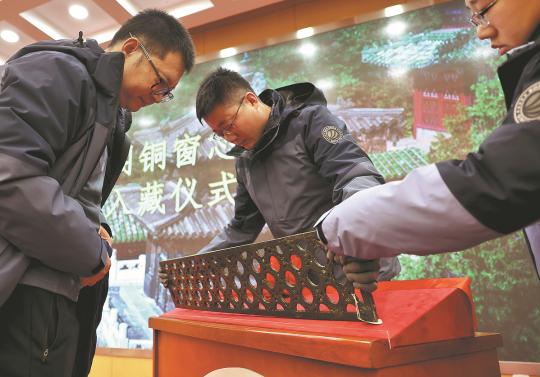Lost Summer Palace bronze panel returned
From:China DailyAuthor: 2024-01-11 15:04

Relics experts inspect the bronze latticed panel returned to the Summer Palace in Beijing during a ceremony on Wednesday. (Photo by Jiang Dong/China Daily)
A long-lost bronze relic from the Summer Palace in Beijing has been returned from overseas and was transferred back to its home on Wednesday.
The bronze latticed panel, 1.05 meters long by 19.8 centimeters wide, was originally set on a window of Baoyun Ge ("a pavilion of treasured clouds") in the compound of the former royal resort during the Qing Dynasty (1644-1911). It was lost in the early 20th century.
Li Lei, a Chinese collector, found the latticed panel in an auction catalog last year in France. Being familiar with patterns of Qing royal relics, he suspected it was from imperial architecture during the reign of Qianlong (1736-95), and was probably from the Summer Palace.
He and two friends, Li Yang and Zhang Jue, bought the lattice, brought it back to China, and donated it to the National Cultural Heritage Administration.
By comparing its patterns, structure and materials with other lattices that remain in situ, experts confirmed that the lost component was from Baoyun Ge.
An old photo of the pavilion, taken by pioneering Scottish photographer John Thomson in 1871, also helped to ensure its identity.
"As an ordinary person, it's a great honor to make a contribution to the protection of our country's cultural relics," Li Lei said at a ceremony on Wednesday to transfer ownership of the window panel to the Summer Palace administration.
"I will be proud that I can tell my children one day when we visit here: 'Look at that, daddy brought one of its windows back.' This is enough for me. I don't want a big reputation."
Built in 1755 beside Foxiang Ge ("tower of Buddhist incense") — the landmark and the highest building in the Summer Palace — Baoyun Ge on the Hill of Longevity is the only surviving Qing imperial architecture entirely built in bronze. About 207 metric tons of bronze was used for its construction, according to Wei Lijia, a cultural heritage conservator at the Summer Palace administration.
Qing royals used it for important Buddhist rituals and Emperor Qianlong later ordered the building of its replica in the Mountain Resort in Chengde, Hebei province. Unfortunately, that replica was dismantled and melted down by the invading Japanese army in 1944 to make bullets.
The original pavilion in the Summer Palace also endured an attack by Anglo-French Alliance Forces in 1860 who burned and destroyed many key pieces of architecture at the Summer Palace. Baoyun Ge became one of the few survivors due to its bronze structure, but its interior settings were ransacked. In 1900, dark days came again as it was hit by the Eight-Nation Alliance Forces during the Boxer Rebellion. Out of its 70 latticed panels on doors and windows, 31 panels were later found to have disappeared.
Chinese relic conservators have long searched for these lost panels. In 1993, Maurice Greenberg, an entrepreneur from the United States, donated 10 windows, including 20 panels, back to China after he bought them in Paris. Another panel was returned by a French antique authentication expert in 1995.
"The whereabouts of the last nine missing panels remains unknown," Wei said. "We hope the donors' good deed might inspire others to find and bring other lost pieces back home for the restitution of the pavilion."
This year marks the 110th anniversary of the Summer Palace opening to the public, and a series of celebratory activities has been launched alongside the return of the panel.
Edit:董丽娜
The copyright of the article and the picture belongs to the original author. If there is any infringement, please contact to delete it